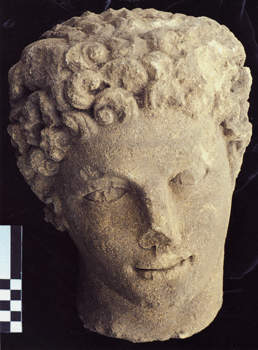
|
| The head of the cult statue of Mercury, excavated at Uley. It is carved in Cotswold limestone. The wings which once sprouted from the god's head are now lost. (Woodward 1993 fig. 7) |
In 1976 laying of a water main in a field on West Hill (ST 789996) above the village of Uley, Gloucestershire, brought to light Roman period artefacts and structures. Subsequent excavation over three seasons (1977-1979) revealed a sanctuary that existed from the late Iron Age through the Roman period into the early medieval era, when it perhaps became a Christian church. The possible presence at Uley of a ceremonial site of Neolithic date may extend its history as a sacred place back into the third millennium BC.
The intrinsic interest of the finds, including curse tablets and votive offerings as well as the buildings of the sanctuary and fragments of the god's statue, confers great significance on the Uley project. Equally important is the high quality of archaeological excavation. Prior to the 1970s, the primary concern of archaeologists excavating sanctuary sites had been to establish the plans of temples, reconstruct their architecture and identify the deity or deities worshipped. Uley was among the first projects to collect, analyse and publish the full range of artefactual and biological evidence from a temple site. This allowed a reconstruction of a very full picture of ritual and other activity at a single shrine over half a millennium. The high resolution recording of the findspots of individual artefacts has also enabled archaeologists to explore which activities took place in which part of the site and the processes by which tablets and other votive materials came to be deposited where they were found. The results of the excavation remain a significant resource for the study of Romano-British religious ritual.